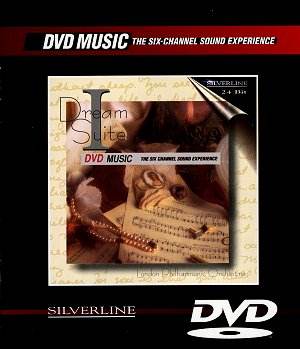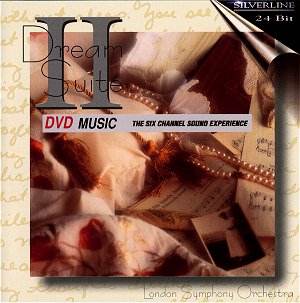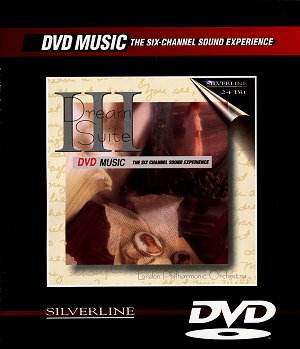‘Dream Suite I, II, and III’
Disk 1:
 |
1 |
DEBUSSY | Clair de Lune | 4.00 |
|
2 |
CHOPIN | Piano Concerto #1: Romance | 4.03 | |
|
3 |
MENDELSSOHN | A Midsummer Night’s Dream: Nocturne | 5.04 | |
|
4 |
ROSSINI/RESPIGHI | La Boutique Fantasque: Nocturne | 3.40 | |
|
5 |
CHOPIN | Nocturne, Op 9 #2 | 4.11 | |
|
6 |
HANDEL | Xerxes: ‘Ombra mai fu’ | 3.18 | |
|
7 |
ELGAR | Dream Children | 2.50 | |
|
8 |
TCHAIKOVSKY | Sleeping Beauty Ballet: Panorama | 2.50 | |
|
9 |
SCHUMANN | Scenes from Childhood: Träumerei | 2.57 | |
|
10 |
BRAHMS | Symphony #3: Poco Allegretto | 5.55 | |
|
11 |
GRIEG | Lyric Suite, Op 54: Notturno | 3.56 | |
|
12 |
BEETHOVEN | Piano Sonata #14, ‘Moonlight’: Adagio Sostenuto | 5.16 |
![]() Don Jackson conducting
the London Philharmonic Orchestra
Don Jackson conducting
the London Philharmonic Orchestra
Recorded at Abbey Road Studios, London, no date given.
No credit given for orchestrations of works originally not written for
orchestra.
Speaker level adjustment utility DVD-Audio 24 bit 5.1 Dolby surround
![]()
![]() SILVERLINE
86002-9 [49.45]
SILVERLINE
86002-9 [49.45]
Disk 2:
 |
1 |
DEBUSSY | Reverie | 4.45 |
|
2 |
CHOPIN | Fantasie Impromptu: | 3.17 | |
|
3 |
BIZET | L’Arlesienne Suite #1:Adagietto | 2.45 | |
|
4 |
BOCCHERINI | String quintet in E:Minuet | 3.26 | |
|
5 |
BEETHOVEN | Sonata #8 Pathetique:Adagio Cantabile | 4.48 | |
|
6 |
HAYDN | Symphony #44:Adagio | 4.30 | |
|
7 |
DVORAK | Symphony #9 in e, New World:Largo | 4.33 | |
|
8 |
MOZART | Eine Kleine Nachtmusik:Allegro | 5.55 | |
|
9 |
TCHAIKOVSKY | None but the Lonely Heart: | 3.46 | |
|
10 |
HANDEL | Solomon:Arrival of the Queen of Sheba | 3.15 | |
|
11 |
ELGAR | Enigma Variations:‘WN’ | 2.02 | |
| ‘Nimrod’ | 3.30 |
![]() Don Jackson conducting
the London Symphony Orchestra
Don Jackson conducting
the London Symphony Orchestra
Recorded at Abbey Road Studios, London, no date given.
No credit given for orchestrations of works originally not written for
orchestra.
Speaker level adjustment utility DVD-Audio 24 bit 5.1 Dolby surround
![]()
![]() SILVERLINE
81007-9 [47.03]
SILVERLINE
81007-9 [47.03]
Disk 3:
 |
1 |
GRIEG | 2 Lyric Pieces: At the Cradle | 3.56 |
|
2 |
BACH | Suite #3 in D: Aria | 5.04 | |
|
3 |
Fauré | Masques et Bergamasques: Pastorale | 4.13 | |
|
4 |
MASSENET | Thais: Meditation | 5.14 | |
|
5 |
BIZET | Petite Suite #4 Duo: Jeux d’Enfants | 3.12 | |
|
6 |
SAINT-SAËNS | Carnival of the Animals: Le Cygne | 3.03 | |
|
7 |
OFFENBACH | Tales of Hoffmann: Intermezzo & Barcarolle | 3.43 | |
|
8 |
TCHAIKOVSKY | Symphony #6, Pathetique: Andante | 2.49 | |
|
9 |
MENDELSSOHN | Symphony #5, Reformation: Andante | 3.27 | |
|
10 |
HUMPERDINCK | Hansel and Gretel: Evening Prayer | 2.47 | |
|
11 |
HAYDN | Symphony #94, ‘Surprise’: Andante | 4.28 | |
|
12 |
BRAHMS | Wiegenlied ‘The Lullaby’ | 5.08 |
![]() Don Jackson conducting
the London Philharmonic Orchestra
Don Jackson conducting
the London Philharmonic Orchestra
Recorded at Abbey Road Studios, London, no date given.
No credit given for orchestrations of works originally not written for
orchestra.
Speaker level adjustment utility
DVD-Audio 24 bit 5.1 Dolby surround
![]()
![]() SILVERLINE
86015-9 [47.32]
SILVERLINE
86015-9 [47.32]
Contact 5.1 Entertainment
Well, there you have it, thirty six pieces which make up the What’s What of nice quiet, lyrical, classical music. The arrangements are intelligent and thoughtful, the playing everything one would expect from two of the world’s greatest orchestras, the ambient sound clear and undistorted, the instruments nicely but not obtrusively separated. But these are DVD-Audio disks, and when you play them on your dvd player and turn on the video screen you will see pictures, which begin immediately after a tasteful credit and without dire threats of police action or lawsuits. Only if you press the MENU or TITLE key on your player remote are you shown the list of options. Move down to OPTIONS and you will see that you have a channel balance utility and a short lecture on speaker placement which could be quite helpful. Under visuals are listed three themes on each disk to select from. Take my advice, stick with Flowers or Instruments.
One’s first indication of trouble would be the number of people on the payroll. Besides the entire personnel of two of London’s largest orchestras we have consultant after consultant in various world capitals, then begin the ‘special thanks.’ One has the idea that here was a project set up by a committee which frequently disagreed, perhaps after most of the money had gone for fees and the project wasn’t making progress.
Under the heading ‘European Art’ we have nice paintings of groups of naked people in the woods quickly replaced by discrete closeups of a leaf here or a hand there. Under ‘Fire’ we are shown a still view of the CD box on fire, which would suggest that one should drop it quickly to avoid burns; there follow some arty still views of swirls of flames in the air engulfing various other inappropriate and inflammable objects. Under ‘Flowers’ we have extreme closeups of various vegetable sexual organs which make nice abstract patterns in vivid colours. Under ‘Instruments’ we have abstract views of musical objects and subjects; this is definitely the safest alternative. Under several scenery related headings there are some original photographic sequences, including a nice one of low sun in a grove of frosted pine trees, but we move on to a collection of stock scenic still shots of the American West, which change, in apparent random order, every eight seconds or so. It seems at one point the pictures were intended either to be in motion, or fade into one another, but this part of the project was apparently stopped in mid flight, with some of the pictures remaining unaccountably merged with others, so we have trees that suddenly begin to grow in mid air, waterfalls that fall nowhere, and clouds that jump about round an improbably large moon. At some point a rebel group must have gained control of the committee and ordered the thing sent to market as-is regardless, and here we have it.
Obviously this is lovely music for people who don’t want to read about it, because the notes attain a new superlative in illegibility—thin, small, designy type over a cluttered color background of silks and jewels. In case you find the case notes difficult, inside the same thing is repeated two to four times smaller.
If you want a nice collection of lovely music, here it is. The surround sound is clear and pleasing. Leave the TV off, or stay with ‘Instruments.’ But for heaven’s sake don’t pay more than £10 for the whole collection; if you wait long enough it may be remaindered for even less than that at your local supermarket.
Paul Shoemaker